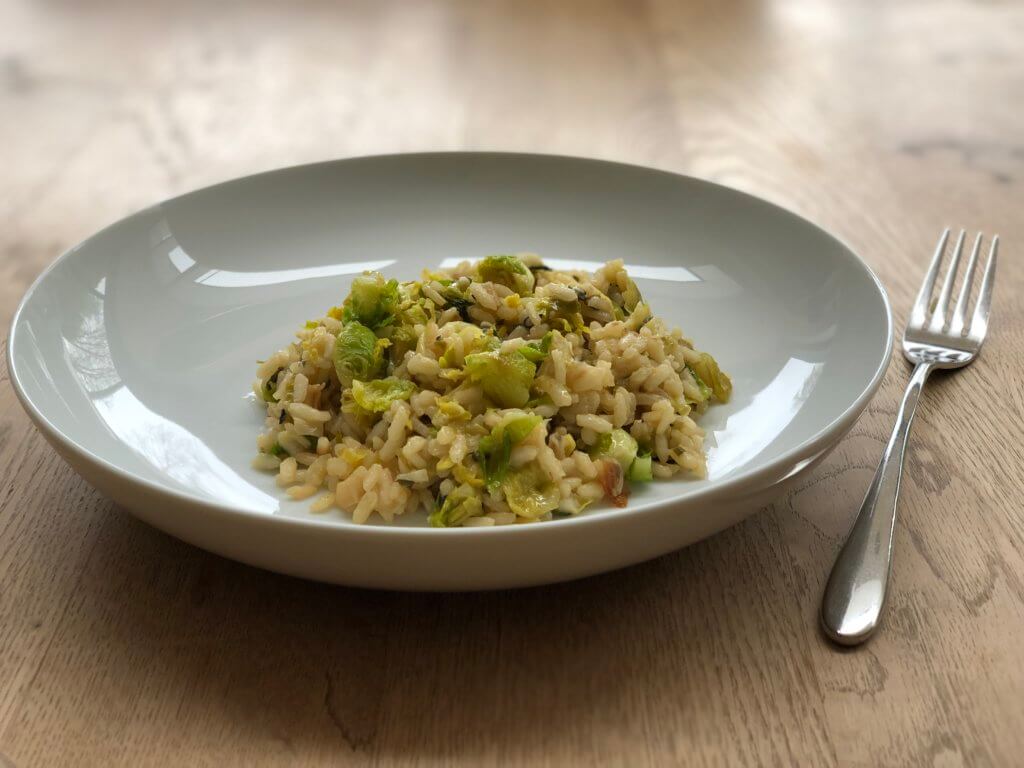Brussels sprout risotto

Although Peter loves sprouts, it was the Dolcelatte in this recipe that initially put him off – he’s not a great fan of blue cheese… However, he gamely offered to give it a go and, I’m pleased to report, was instantly won over.
I only mention this because the clever thing about this dish is that the blue cheese lends a very subtle flavour, and everything is perfectly in balance. As a result, it really is hard to dislike – unless you have an aversion to Brussels sprouts of course. This is another Yotam Ottolenghi recipe.
INGREDIENTS
- 30g unsalted butter
- 2 tbsp olive oil
- 2 small onions or banana shallots, finely chopped (200g)
- 2 large garlic cloves, crushed
- 2 tbsp thyme leaves
- 2 lemons, rind shaved in long strips from one; finely grated zest of the other
- 300g risotto rice
- 500g trimmed Brussels sprouts, 200g shredded and 300g quartered – instead of the 300g of quartered sprouts you can use halved kalettes or kale sprouts which will lend a lovely deep colour with a hint of purple here and there
- 200ml dry white wine
- 900ml hot vegetable stock
- Approx 400ml sunflower oil
- 40g Parmesan, grated
- 60g Dolcelatte, broken into 2cm chunks
- 10g tarragon leaves, roughly chopped
- Salt and black pepper
DETAILS
- Cuisine: Vegetarian
- Prep Time: 10 minutes
- Cook Time: 25-30 minutes
- Serves: 4
METHOD
Place the butter and olive oil in a large frying pan on a medium-high heat. Add the onion and fry for 10 minutes, stirring occasionally, until soft and lightly caramelized. Add the garlic, thyme and lemon strips and cook for a further 2 minutes.
Add the rice, along with the shredded sprouts, and cook for another minute, stirring frequently. Pour over the wine and let it simmer until almost evaporated, then begin adding the stock along with 1 tsp of salt and a twist of black pepper.
Turn the heat down to low-medium and carry on adding the stock in ladlefuls, stirring frequently, until the rice is cooked but still retains bite. This will take around 15 minutes more, by which time you should have used up most, if not all, of the stock.
While the rice is cooking, pour the sunflower oil into a separate large saucepan; it should come 2cm up the sides. Place on a high heat and, once very hot, use a slotted spoon to add a handful of the quartered sprouts: make sure they are dry before being fried; they will still spit so be careful.
Fry the sprouts until crispy and golden, then transfer to a plate lined with kitchen paper. Keep somewhere warm and repeat with the remaining sprouts.
Add the Parmesan, Dolcelatte, tarragon and half the fried sprouts to the cooked risotto and stir gently. Serve at once with the remaining sprouts spooned on top, followed by the grated lemon zest and juice.
DRINKS
With the blue cheese and bitter vegetable kick of the sprouts, a soft and juicy wine is required. Red, white and rosé are all worth considering; from a summer fruited New World Pinot Noir to a ripe style of Viognier – or even a fruity Spanish rosé.
